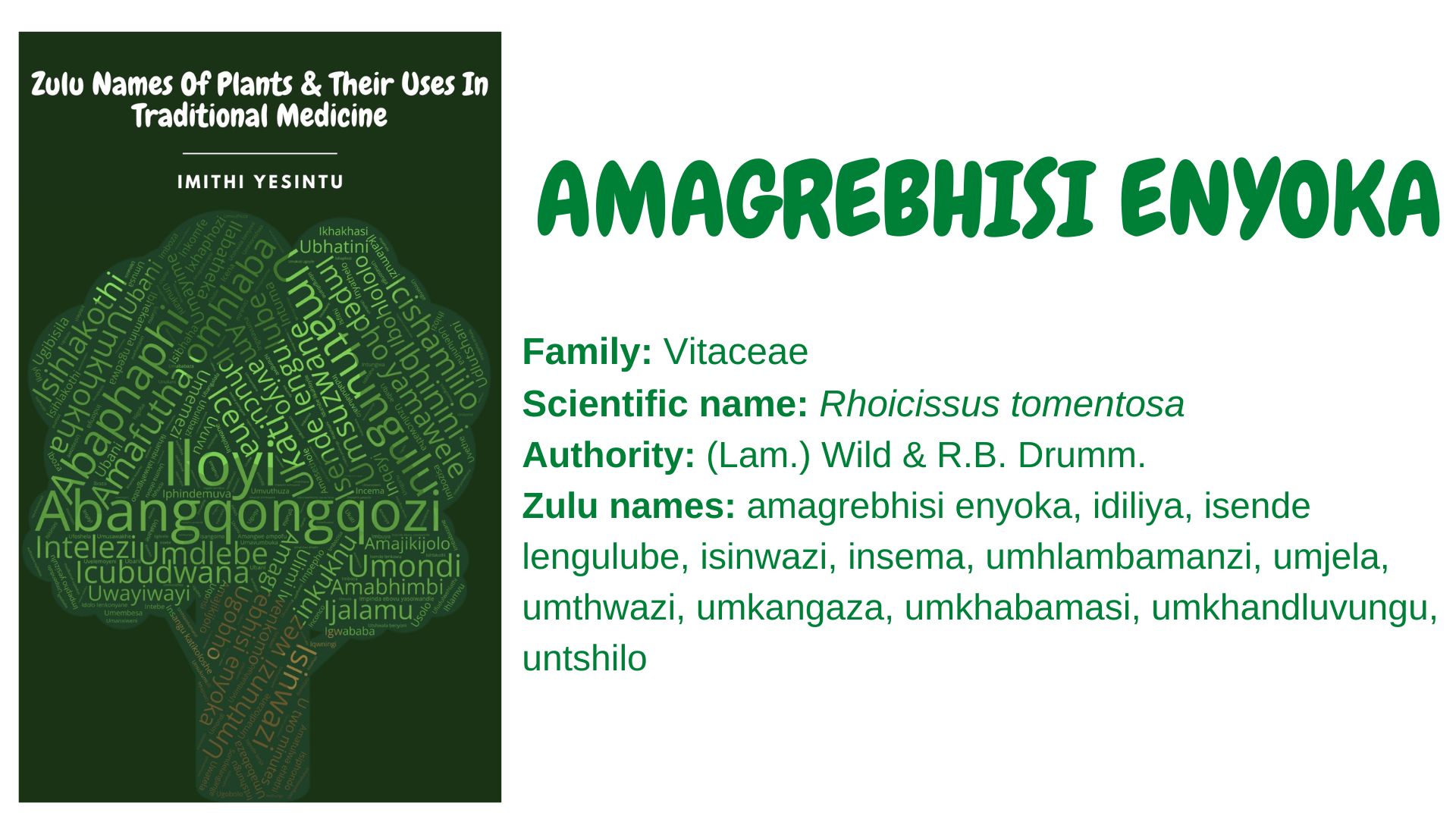Family: Vitaceae
Scientific name: Rhoicissus tomentosa
Authority: (Lam.) Wild & R.B. Drumm.
Synonyms: Cissus capensis Willd., Rhoicissus capensis (Willd.) Planch., Vitis capensis (Willd.) Thunb.
Zulu names: amagrebhisi enyoka, idiliya, inqaningi, insema, isende lengulube, isinwazi, umjela, umhlambamanzi, umkangaza, umkhabamasi, umkhandluvungu, umthwazi, unungwane, untshilo
Other names: common forest grape, monkeyrope, simple-leaved grape, wild grape, wild vine (English) bobbejaantou, bosdruif, bosdruiwe, gewone bosdruif, wildedruif, wildedruiwe (Afrikaans)
Plant description: R. tomentosa is an evergreen herbaceous vine with ornamental kidney shaped leaves that have lobes along the margins, small creamy green flowers, and clusters of edible grape-like fruits that turn dark purple when ripe. Each fruit contains about three small pear-shaped seeds. This vine can be found growing in the forests and the banks of streams. It is distributed in South Africa, Zimbabwe, and Malawi.
Uses:
- In some cases, R. tomentosa is often used in place of umavumbuka.
- The edible fruits are used to make jelly, vinegar, and wine.
- The leaves are used to make powder that is inhaled to cleanse the nasal passages and to treat chronic headaches.
- The roots are used for blood purification.
- The root decoction is used to treat skin infections such as acne.
- The roots are used to make a decoction to treat isidina, the overproduction of sebum on the face especially around the nose area.
- The roots are an ingredient that is used to make inembe, a tonic taken by pregnant women to ensure a safe delivery.
- The roots are also used to ensure safe delivery in animals.
- The roots are used to treat sterility in both humans and animals.
- The roots are used to treat bladder, kidney, and renal complaints.
- The roots are used to treat intestinal worms.
- The roots are used as an emetic and as a steaming agent.
- The roots are boiled in milk and the mixture is used as anthelmintic, to expel parasitic intestinal worms.
- This plant is used to hasten maturation in young girls by treating delayed menstruation. It is also used to treat dysmenorrhoea and menorrhagia.
- The roots are used to generate sperm in boys.
- The roots are used to treat abdominal pains, stomach ache, and swelling.
- The roots are used to treat sores, cuts, broken bones, and sprained ankles.
- The plant is used to treat epilepsy and convulsions.
Safety precaution:
Using traditional medicine responsibly can enhance your overall health and well-being. Misuse and abuse can lead to complications. You can inquire about the correct use of traditional medicine from a knowledgeable herbalist and practitioner. You can also visit imithiyesintu.co.za or email: info@imithiyesintu.co.za to learn more about traditional medicine
References and further reading:
- Boon, R. and Pooley, E., 2010. Pooley’s trees of eastern South Africa. Flora and Fauna Publications Trust.
- Foden, W. and Potter, L. 2005. Strychnos madagascariensis Poir. National Assessment: Red List of South African Plants version 2020.1. Accessed on 2023/04/27
- Gerstner, J., 1938. A preliminary checklist Zulu names of plants with short notes. Bantu Studies.
- Gerstner, J., 1941. A preliminary checklist Zulu names of plants with short notes. Bantu Studies.
- Hutchings, A. and van Staden, J., 1994. Plants used for stress-related ailments in traditional Zulu, Xhosa and Sotho medicine. Part 1: Plants used for headaches. Journal of Ethnopharmacology, 43(2), pp.89-124.
- Mshengu, B., Uwumubyeyi, V. and Moodley, R., 2020. Chemical constituents from Rhoicissus digitata and Rhoicissus tomentosa and their chemotaxonomic significance. South African Journal of Botany, 135, pp. 87-91.
- Mhlongo, L.S., 2019. The Medicinal Ethnobotany of the Amandawe Area in KwaCele, KwaZulu-Natal, South Africa. University of Johannesburg (South Africa).
- Notten, A., 2004. Rhoicissus tomentosa (Lam.) Wild & RB Drumm.(= R. capensis) (Vitaceae).
- Nqolo, N.L., 2008. Phytochemical study of Rhoicissus tomentosa (Doctoral dissertation, University of the Western Cape).
- Pujol, J., 1990. Natur Africa: The Herbalist handbook. Lean Pujol Natural Healers Foundation, Durban.
- Van Wyk, B.E., Oudtshoorn, B.V. and Gericke, N., 1997. Medicinal Plants of South Africa. Briza.
- Watt, J.M., and Breyer-Brandwijk, M.G., 1962. Medicinal and poisonous plants of southern and eastern Africa, second edition. Livingstone, London.
You Can Order Your Copy Of The Book By Emailing: info@imithiyesintu.co.za
Feel Free To Add Other Uses Of This Plant In The Comment Section Below:
